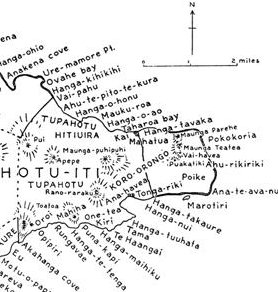7. There is a glyph type takaure (as described earlier):
Only one takaure glyph is on side a of G, and it presumably shows where the takaure season is ending:
If we count Gb8-30 twice, which we should, then the blackmarked glyphs will cover 151 + 85 = 236 days (= 8 * 29.5 = 472 / 2 or half the total cycle of the text).
In Gb3-30 (with ordinal number 364 / 4 = 91 counted from Gb1-1) there is a pau 'foot' - resembling that in Gb5-12 (Hanga Te Pau) - and its meaning ought to be similar, probably indicating 'end' (i.e. here of the summer 'year'):
We can guess Hanga Takaure corresponds to tagata in Ga4-1. On the map of Métraux this 'Bay of Flies' is located at the southern end of the famous ditch crossing the Poike peninsula:
Tama (where the child is born) is earlier and One Tea (where the Moon Queen dies) is between Tama and Hanga Takaure. King Sun evidently returns at Hanga Takaure. The 'flies' ought to indicate how his living spirit is descending to invigorate the baby boy. Such are examples of conclusions we can draw. Moon is rising in the west and advances along the southern coastline to reach her end at One Tea, the beach with white (tea) sand (one). Sun will presumably rule the rest of the coastline around the island, and his first station will be Hanga Takaure, appropriately a station of Mars:
In the calendar of G we can identify Tama and One Tea from the fact (yes, such a high degree of probability must lead us to use this word) that each glyph stands for a day (or 'night', po, as the Polynesians once used to say):
Thursday at Gb7-2 is day number 413 = 14 * 29.5 = 7 * 59, and next follows a day of Venus with the glyph type tamaiti (child). 15 * 29.5 = 442½, but this odd number is maybe worthless if we are counting doublemonths. 8 * 59 = 472 identifies Hanga Takaure as Gb8-30, the glyph which must be considered both as the last one of the old cycle and the first one of the following cycle:
In Ga1-4 vaha mea ('red opening') indicates how the black cloth of winter has been removed. The change is illustrated by puo in Gb8-30 (where the 'sweet potato' still is 'hilled up') and the gesture of opening in Ga1-1. Jupiter is transformed into Mercury (indicated both by number and by a cup sign) and then Saturn arrives to light the new fire:
|
||||||||||||||||||||||||||||||||||||||||||||||||||||||||||||||||||||||||||||||||||||||||||||||||||||||||||||||||||||||||||||||||||||||||||||||||||











